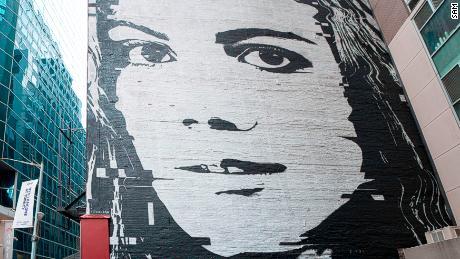New York street art shines a light on human trafficking

“I felt like it was never going to end. I was raped all the time, I was bought all the time, people would come and do unimaginable things to me,” she told CNN. Thompson, aged 23, is now free, though she still bears the scars. She has bite marks on her neck and a scar on her arm from when a pimp attacked her with a knife.”I may be physically out, but I still feel mentally trapped… Even to this day, I still struggle with viewing myself as a person who’s worth something more than sex or money,” she said. Thompson’s story is now represented in a mural on Manhattan’s 25 Bridge Street, and her experience can be heard by simply scanning the image using the “Behind the Wall” phone app.This is part of an initiative by the NGO Street Art for Mankind (SAM) to raise awareness of child slavery through art. Street art for slaveryThe campaign features six graffiti murals by international artists, depicting different forms of slavery across the world, including sex trafficking in the US, domestic slavery in Europe, and child soldiers in Africa — as well as child labor in the fashion industry in Asia, the fish industry in Latin America and the chocolate industry in Africa.The images are not direct representations of the victims, but rather an “allegory of the issue,” said Audrey Decker, co-founder of SAM along with her husband Thibault Decker. “The point being that this child could be any child, including ours,” she added.SAM’s core mission is to fight against human and child trafficking through art. Audrey Decker believes that putting the subject in front of the public in the form of street art will help people realize that modern slavery is everywhere. “That’s why it was important to include a local survivor,” she said. “People weren’t aware it was happening here… So we decided to make a statement to show it happens right on our doorstep.”Freedom walkOn May 10, members of the public will join street artists, trafficking survivors, legislators and anti-trafficking campaigners in a two-mile walk across Lower Manhattan, viewing each mural. Speaking at the event is Cecile Noel, commissioner of the NYC Mayor’s office to end domestic and gender-based violence. “Using public spaces for art, just as SAM does, is a critical way to start dialogues and advocate for change,” she told CNN.The Mayor’s Office has taken various actions to help trafficking survivors. Last May, the city announced a paid sick and safe leave law for victims of domestic violence and human trafficking, that allows employees to take paid time off to recover from abuse or trafficking crimes. It has also opened family justice centers in all five boroughs of the city, that provide counseling and legal assistance to survivors.However, Noel says there is still a lack of awareness of the issue. “Trafficking is a global issue and it is grossly underreported,” she said. “New York continues to be both a gateway and a destination for trafficking, underscoring the need for both prevention and intervention at the local level.”An estimated 40 million people around the world were victims of modern slavery in 2016, according to the International Labour Organization. Of these, one in four victims were children. In the US, there was an estimated 403,000 people are living in trafficking situations, according to the Global Slavery Index.Thompson said it is vital to get the message out that this is a domestic problem. “Everybody believes that it only happens in places like India, or China, or Russia or Thailand,” she said. “But people need to really open their eyes and understand that this happens right around them every day.”



